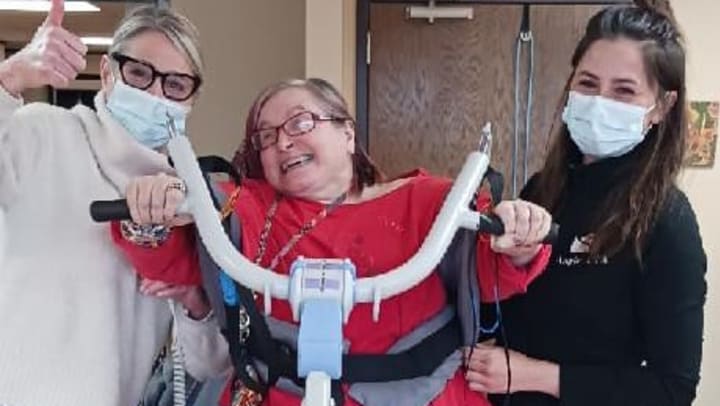Physical therapy (PT), occupational therapy (OT), and speech therapy (ST) play an integral role in the management of primary progressive multiple sclerosis (PPMS). A recent success story at East Troy Manor highlights the importance of PT, OT and ST of Amy, a 51-year-old who was diagnosed with PPMS in 2006. The severity of PPMS symptoms varies with each person and include pain, muscle spasms, trouble with sitting and standing balance, trouble walking, vision problems, muscle weakness, paralysis, numbness, decreased sensation, dizziness, changes in speech patterns, trouble thinking clearly, mood changes and trouble with the bowel and bladder.
We are excited to be working with Amy, who recently moved to East Troy Manor for therapy. She has significant changes in neurological function related to the disease. Amy has muscle paresis affecting her left side with muscle spasms in her left leg. Amy has been sitting in a Broda chair for one year. Some of the disadvantages of sitting in the chair for an extended period include her lack of head control, a lateral lean to her right side and sliding forward while seated.
Upon initial evaluation, Amy required total assistance with bathing and dressing and has been dependent on a Hoyer lift for all transfers. She was unable to sit upright and required assistance to feed herself. PT has been working with Amy to regain her strength and flexibility and improve her functional mobility. OT has been focusing on general function to accomplish daily tasks.
Amy has difficulty communicating, and ST is working on a communication board and educating staff on the meaning of the signs she uses to meet her needs. PT and OT worked together with a certified nursing assistant (CNA) to help Hoyer lift Amy into a standard wheelchair. She has progressed from tolerating 30 minutes in the wheelchair to over 6 hours a day. Amy can now use her trunk muscles to pull herself forward and is able to feed herself while sitting in the wheelchair. As her sitting tolerance improved, PT, OT and a CNA used the Easy Stand mechanical lift to stand with Amy, and she was absolutely thrilled with her progress. Out of pure joy, she did a little dance (more than once) while standing supported in the Easy Stand. Her tolerance for standing with the support of the stand continues to improve. Our therapy team’s goal is to improve her quality of life and allow her to maintain her independence. Seeing the joy in her face, hearing the shrill in her voice, and feeling her energy was exciting, rewarding and heartwarming.


